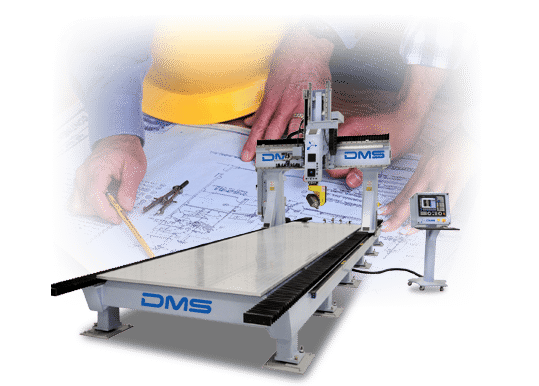A Comparison of Ferrous vs. Non-Ferrous Materials in CNC Router Applications
All materials have a different set of physical and chemical properties, which can make it difficult to understand what material is optimal for a job. The CNC router industry has addressed this issue by researching various options and implementing the use of new materials for the manufacture of CNC equipment. Starting with the basics—all metals can be divided into two categories called ferrous and non-ferrous. We define ferrous metals as those that have a high percentage of iron in their chemical makeup while non-ferrous metals are those that lack iron in appreciable quantities. Important disclaimer: Both categories always have outliers, but still lean toward general property trends that are opposites, and it is important that we contrast the two so that we can get a better picture of their functional differences and applications.
Non-Magnetic vs. Magnetic
Non-ferrous materials are non-magnetic whereas ferrous metals are magnetic. The two types of metal’s difference in magnetic ability propose that they have different functional purposes in CNC mechanisms. For instance, a stepper motor works by activating differently placed magnets one after the other which attracts the rotor in a sequential step-like manner. It is vital that the rotor in this stepper motor be created out of a ferrous metal that is magnetic, such as an iron alloy like silicon steel, otherwise, the rotor wouldn’t be attracted by the magnets, and the mechanism would ultimately fail. A non-ferrous material would simply not be suitable for this kind of rotor.
Highly Conductive vs. Lowly Conductive
Non-ferrous metals are more conductive than ferrous metals. This distinction between the two types of metal is again important when deciding what materials to use for certain mechanisms. For instance, a DC servo motor works by converting electrical energy into mechanical energy. This conversion process is achieved by passing voltage through coils to generate torque ultimately moving the mechanism. For this to work, the coils that receive the electrical current would need to be constructed out of a non-ferrous material like copper so that the electricity can pass through unrestrained, otherwise, the electrical current would fail to convert to mechanical energy and the mechanism would fail to function. In this case, the coil simply cannot be made out of ferrous material.
Thermal Resistance vs. Non-Thermal Resistance
Thermal conductivity and the reciprocal thermal resistance are both properties that concern a material’s ability to handle high temperatures. Some of the top thermal conductive metals are silver, copper, gold, and aluminum which are all non-ferrous, indicating a trend that nonferrous materials tend to hold their heat more than ferrous materials. Thermal resistance is an important concept for CNC manufacturers because heat control and overheating are large issues. In fact, temperature is one of the largest factors in determining tool life. These properties come into play when deciding what material to construct a CNC spindle out of. A CNC spindle can run hot when cutting various metals and require not only heat sinks and coolants, but also a strong dense foundational material that is thermal resistant. A strong durable thermal resistant ferrous material, coupled with other heat prevention techniques, would help maintain tool life and prevent possible damages and errors.
Non-Corrosive vs. Corrosive
Non-ferrous metals tend to be non-corrosive whereas ferrous metals are prone to corrode. This proposes the important issue of longevity. All things naturally deteriorate but some things decompose faster than others. It would be wise to promote the healthiest machine by creating the frame out of non-ferrous metals to create longer-lasting machines which would also reduce company preventative maintenance expenses. There are other corrosion protection techniques like cathodic protection that can make it possible to use ferrous materials as the frame without worrying about corrosion and short longevity. Essentially, by adding what is called sacrificial anodes made out of nonferrous materials such as copper or nickel you can transfer corrosion from the machine to the anode. This is a popular method that allows machines made of steel like the CNC routers at DMS to live healthy lives free of the blight of corrosion. Both are equally good options depending on the specific demands of the machine.
Machining Dense vs. Not Dense Materials
When it comes to machining ferrous and non-ferrous metals, a CNC router’s ability to handle them is based on their density. Ferrous materials are made mostly of iron which means most of them are dense, like steel. Most heavy-duty cutting is normally done at slow spindle speeds and high horsepower. CNC routers typically act in the opposite direction where they cut at high spindle speeds at low horsepower, but with the proper heavy-duty components and coolants, they can be adapted to work with ferrous materials. Diversified Machine Systems (DMS) offers CNC routers ideal for high-speed machining and trimming of aluminum and other non-ferrous metals, as well as robust routers designed for working with ferrous materials. Our products address a wide variety of applications from mold and pattern machining to honeycomb core as well as carbon fiber machining to hydroform trimming.
- 1. http://en.wikipedia.org/wiki/Stepper_motor
- 2. Stepper Motors : Fundamentals, Applications And Design by V. V. Athani p. 176
- 3. http://vlab.ee.nus.edu.sg/~bmchen/courses/EG1108_DCmotors.pdf pg. 2
- 4. http://en.wikipedia.org/wiki/Cathodic_protection
- 5. http://en.wikipedia.org/wiki/Sacrificial_anode


